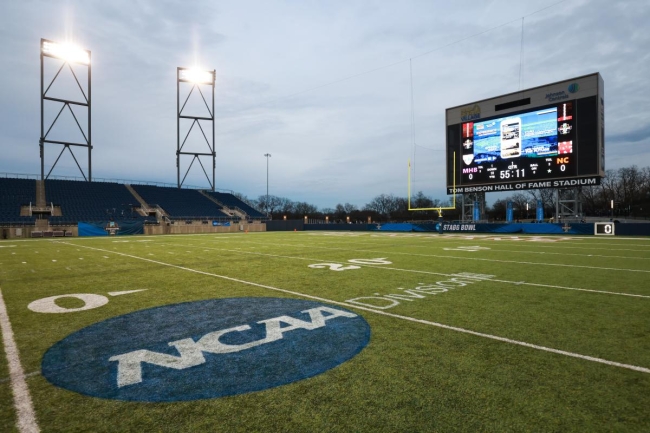You have /5 articles left.
Sign up for a free account or log in.

Many of the objections to the new NCAA constitution came from Division III members.
Justin Tafoya/NCAA Photos/Getty Images
A new NCAA constitution is now in place despite the objections of some members who voted against the proposal Thursday. They dissented for a variety of reasons, including that too much money and power are concentrated in the hands of Division I colleges, to the detriment of others.
The vote to approve a new constitution passed with 801 votes in favor, 195 against and 20 abstentions, with members casting ballots both online and in person at the NCAA convention in Indianapolis. Ratification required approval by two-thirds of the NCAA membership, which it easily achieved.
The new NCAA constitution makes a number of reforms as it shrinks the original document from 43 pages to 19. These changes come amid the fallout of the Alston opinion, a Supreme Court ruling that struck down NCAA restrictions on academic benefits for student athletes on antitrust grounds and paved the way for students to profit off their name, image and likeness. The Alston case, decided in the summer of 2021, prompted the NCAA to quickly reverse course on NIL. Now the new constitution reflects changes to NIL policy and a number of other updates.
Key changes outlined in the new NCAA constitution include:
- Reducing the NCAA Board of Governors from 21 to nine voting members, four representing Division I colleges or conferences and one each from Division II and Division III, two independent representatives not employed by member institutions, and a recently graduated student athlete. Additionally, the Board of Governors will have a nonvoting ex officio member from a historically Black college or university and two nonvoting former student athletes.
- More autonomy for divisions to develop their own policies.
- Language changes to limit punishment leveled for infractions against innocent parties such as student athletes who were not on the team at the time rules were broken.
- New language notes players “may receive educational and other benefits in accordance with guidelines established by their NCAA division,” though pay for play remains barred.
Arguments For and Against the New Constitution
Pushback on the new NCAA constitution focused more on what was missing in the proposed document than what was included. A number of speakers, particularly from Division II and Division III colleges, objected to issues such as limited revenue sharing and a lack of representation. They also argued that the NCAA rushed the constitutional reform process due to political pressure.
Hiram Chodosh, president of Claremont McKenna College, a Division III school, declared that the NCAA is “in crisis,” pointing to issues of sexual assault, falsified grades, inequitable treatment across race and gender lines, and the looming threat of antitrust litigation or legislation.
“In addressing these scandals and the underlying corrosive impact of money on ethical judgment, we face a major question: How can we restore amateur athletics through effective measures that will limit the corrosive influence of money and simultaneously distribute revenue from lucrative commercial activity in principled, equitable, inclusive ways?” Chodosh said.
He added that changes in the constitution, such as language addressing name, image and likeness, and modest budgetary adjustments, amount to dressing in windows that remain closed.
“There’s no real transformative change in this document,” Chodosh said.
George Bright, athletic director at Division II Elizabeth City State University, a historically Black institution, objected to a lack of representation for HBCUs, citing the nonvoting ex officio position on the Board of Governors. He argued that the new constitution fails to reflect a commitment to diversity, equity and inclusion.
“When you marginalize the HBCU vote, you marginalize our opportunity by keeping us neutral in the power structure, where decisions are being made about how our students are being treated in the classroom and on the fields,” Bright said.
Jack DeGioia, president of Georgetown University and current chair of the NCAA Board of Governors, noted that the creation of the nonvoting ex officio position “does not limit the ability of an HBCU president to serve as a member of the Board of Governors in a voting capacity.”
Others objected to the lack of adjustments for revenue allocation for Division II and Division III colleges, which will continue to receive 4.37 percent and 3.18 percent, respectively.
“In the name of equity, both Division II and Division III should receive substantially more revenue than they currently receive from the NCAA. Even a slight goodwill increase, to 5 percent for Division II and Division III, would still leave 90 percent of the net revenue for Division I,” said Bill Thierfelder, president of Belmont Abbey College, which is a member of Division II.
But the new NCAA constitution also had its advocates.
Student athlete representative Mads McKenna emphasized the constitution’s commitment to improving the collegiate experience for the players and urged others to cast a yes vote.
“Furthermore, the proposed constitution strengthens school accountability to student athletes for both physical and mental health and well-being,” McKenna said. “As a constitution committee member and a student athlete, I am especially proud of this emphasis on mental health.”
Daryl Simms, athletic director at the Division III University of Wisconsin at Oshkosh, urged his fellow NCAA members to vote for the proposed constitution despite the objections they had.
“The new constitution may not include everything we wanted, but it represents a compromise of what's best for everyone, for the student athletes in particular,” Simms said. “There are improvements for the association, specifically Division III, that should not be dismissed. We have the autonomy to move forward in lockstep to improve opportunities for student athletes.”
The freshly approved NCAA constitution will go into effect Aug. 1.
NCAA Updates Policies for Transgender Athletes
Beyond the new constitution, another notable change to NCAA policies, effective immediately, occurred at the convention Wednesday as the Board of Governors voted to amend rules regarding transgender student athletes to give each sport autonomy in decision making. The NCAA is adopting a “sport-by-sport approach to transgender participation that preserves opportunity for transgender student-athletes while balancing fairness, inclusion and safety for all who compete,” according to a news release.
The change, the NCAA notes, brings policies for transgender student athletes into line with the United States Olympic and Paralympic Committee and International Olympic Committee.
New NCAA rules will require transgender student athletes “to document sport-specific testosterone levels beginning four weeks before their sport’s championship selections.”
Additionally, beginning in the 2022–23 academic year, the NCAA will require transgender competitors to document testosterone levels at the beginning of the season for their chosen sport and to provide additional documentation to the NCAA six months later. That policy will be fully implemented in the 2023–24 academic year, according to an NCAA news release.








